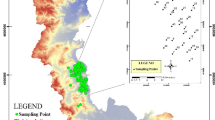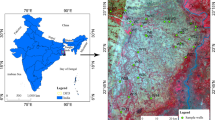Abstract
The present study demonstrates the efficacy of information entropy for the development of water quality index (WQI) for irrigation purpose and its application on Bharalu River. Water quality for irrigation suitability was assessed by using derived parameters such as permeability index (PI), Kelly’s ratio (KR), magnesium adsorption ratio (MgR), sodium adsorption ratio (SAR), soluble sodium percentage (SSP), and residual sodium carbonate (RSC) using annual data from April’2008 to April’2013 and April’2016, April’2017 over a period of 8 years. Values obtained in the study varied from 1.85 to 39.35% for SSP, 0.08 to 1.37 for SAR, 31.7–60.0% for MgR, 0.0–5.45 for RSC, 0.33–2.36% for PI, an 0.01–0.52 for KR. The derived parameters values indicate that water of Bharalu River is suitable for irrigation except April’2008 and April’2011. United States Salinity Laboratory (USSL) and Wilcox diagrams were used for categorizing of water quality. USSL and Wilcox diagrams categorized the water samples as S1-C2 and S1-C3, and ‘Excellent to Good’ and ‘Good to Permissible’ respectively, which suggest River Bharalu’s irrigation suitability. Entropy weighted irrigation water quality index (EIWQI) has been proposed and applied on Bharalu River data for assessing its suitability and variability for irrigation. EIWQI was found to be less than 1 for all the years except April’2011, which showed its appropriateness for irrigation. This study can be of great help for policymakers and researchers to effectively manage water resources.






Similar content being viewed by others
References
Abbasi, T., & Abbasi, S. A. (2012). Water quality indices. Amsterdam: Elsevier.
Abtahi, M., Golchinpour, N., Yaghmaeian, K., Rafiee, M., Jahangiri-rad, M., Keyani, A., et al. (2015). A modified drinking water quality index (DWQI) for assessing drinking source water quality in rural communities of Khuzestan Province, Iran. Ecological Indicators,53, 283–291.
Amiri, V., Rezaei, M., & Sohrabi, N. (2014). Groundwater quality assessment using entropy weighted water quality index (EWQI) in Lenjanat, Iran. Environmental Earth Sciences,72(9), 3479–3490.
APHA. (2012). Standard methods for examination of water and wastewater. Washington: American Public Health Association.
Ayers, R. S., & Westcot, D. W. (1985). Water quality for agriculture (Vol. 29). Rome: Food and Agriculture Organization of the United Nations.
Bhargava, D., & Saxena, B. (1990). A study of the geopollutants in the Godavary river basin of India. Asian Environment,12, 36–59.
BIS, IS 11624–1986. (Reaffirmed 2009). Guidelines for the quality of irrigation water. New Delhi: Bureau of Indian Standards.
Bouguerne, A., Boudoukha, A., Benkhaled, A., & Mebarkia, A.-H. (2017). Assessment of surface water quality of Ain Zada dam (Algeria) using multivariate statistical techniques. International Journal of River Basin Management,15, 133–143.
Domenico, P. A., & Schwartz, F. W. (1990). Physical and chemical hydrogeology (pp. 410–420). New York: Wiley.
Doneen, L. D. (1964). Water quality for agriculture (p. 48). Davis: Department of Irrigation, University of Calfornia.
Dwivedi, S., Tiwari, I., & Bhargava, D. (1997). Water quality of the river Ganga at Varanasi. Journal-Institution of Engineers India Part En Environmental Engineering Division,78, 1–4.
Eaton, F. M. (1950). Significance of carbonates in irrigation waters. Soil Science,69(2), 123–134.
Fagbote, E. O., Olanipekun, E. O., & Uyi, H. S. (2014). Water quality index of the ground water of bitumen deposit impacted farm settlements using entropy weighted method. International Journal of Environmental Science and Technology,11(1), 127–138.
Hameed, M., Sharqi, S. S., Yaseen, Z. M., Afan, H. A., Hussain, A., & Elshafie, A. (2017). Application of artificial intelligence (AI) techniques in water quality index prediction: a case study in tropical region, Malaysia. Neural Computing and Applications,28(1), 893–905.
Horton, R. K. (1965). An index number system for rating water quality. Journal of the Water Pollution Control Federation,37(3), 300–306.
Iscen, C. F., Emiroglu, Ö., Ilhan, S., Arslan, N., Yilmaz, V., & Ahiska, S. (2008). Application of multivariate statistical techniques in the assessment of surface water quality in Uluabat Lake, Turkey. Environmental Monitoring and Assessment,144(1–3), 269–276.
Islam, A. (2012). Water scarcity in the north eastern states of India: Mechanisms and mitigations. Indian Streams Research Journal,II((XI)), 1–7.
Islam, A. R. M. T., Ahmed, N., Bodrud-Doza, M., & Chu, R. (2017). Characterizing groundwater quality ranks for drinking purposes in Sylhet district, Bangladesh, using entropy method, spatial autocorrelation index, and geostatistics. Environmental Science and Pollution Research,24(34), 26350–26374.
Kelly, W. P. (1963). Use of saline irrigation water. Soil Science, 95, 355–391.
Khodapanah, L. W. N. A., Sulaiman, W. N. A., & Khodapanah, N. (2009). Groundwater quality assessment for different purposes in Eshtehard District, Tehran, Iran. European Journal of Scientific Research,36(4), 543–553.
Kundzewicz, Z. W. (1997). Water resources for sustainable development. Hydrological Sciences Journal,42(4), 467–480.
Misaghi, F., Delgosha, F., Razzaghmanesh, M., & Myers, B. (2017). Introducing a water quality index for assessing water for irrigation purposes: A case study of the Ghezel Ozan River. Science of the Total Environment,589, 107–116.
Nagarajan, R., Rajmohan, N., Mahendran, U., & Senthamilkumar, S. (2010). Evaluation of groundwater quality and its suitability for drinking and agricultural use in Thanjavur city, Tamil Nadu, India. Environmental Monitoring and Assessment,171(1–4), 289–308.
Najafzadeh, M., Ghaemi, A., & Emamgholizadeh, S. (2018). Prediction of water quality parameters using evolutionary computing-based formulations. International Journal of Environmental Science and Technology. https://doi.org/10.1007/s13762-018-2049-4.
Paliwal, K. V. (1972). Irrigation with saline water (p. 198). Monogram no. 2 (New series). New Delhi: IARI.
Raghunath, H. M. (1987). Groundwater (pp. 344–369). New Delhi: Wiley Eastern Ltd.
Ramesh, K., & Elango, L. (2012). Groundwater quality and its suitability for domestic and agricultural use in Tondiar river basin, Tamil Nadu, India. Environmental Monitoring and Assessment,184(6), 3887–3899.
Richards, L. A. (1954). Diagnosis and improvement of saline and alkali soils. U.S. Department of Agricultural Handbook, vol. 60, Washington D.C., U.S.A., pp. 160.
Singh, V. P. (2013). Entropy theory and its application in environmental and water engineering. Wiley.
Singh, V. P. (2014). Entropy theory in hydraulic engineering: An introduction. American Society of Civil Engineers.
Thakur, T., Rishi, M. S., Naik, P. K., & Sharma, P. (2016). Elucidating hydrochemical properties of groundwater for drinking and agriculture in parts of Punjab, India. Environmental Earth Sciences,75(6), 467.
Thapa, R., Gupta, S., Reddy, D. V., & Kaur, H. (2017). An evaluation of irrigation water suitability in the Dwarka river basin through the use of GIS-based modelling. Environmental Earth Sciences, 76(14), 471.
Todd, D. K. (1980). Groundwater. Hydrology (2nd ed., p. 315). Willey: Hoboken.
USSL. (1954). Diagnosis and improvement of saline and alkali soil. USDA Hand Book no. 60, Washington.
Wilcox, L. V. (1955). Classification and use of irrigation waters. USDA Circular 969, Washington, p 19.
Wu, P., & Tan, M. (2012). Challenges for sustainable urbanization: a case study of water shortage and water environment changes in Shandong, China. Procedia Environmental Sciences,13, 919–927.
Acknowledgements
Authors appreciatively accept the support from Pollution Control Board, Guwahati (Assam). Board has provided the previous year’s data (April’2008–April’2013) for the study.
Author information
Authors and Affiliations
Corresponding author
Additional information
Publisher's Note
Springer Nature remains neutral with regard to jurisdictional claims in published maps and institutional affiliations.
Rights and permissions
About this article
Cite this article
Singh, K.R., Goswami, A.P., Kalamdhad, A.S. et al. Development of irrigation water quality index incorporating information entropy. Environ Dev Sustain 22, 3119–3132 (2020). https://doi.org/10.1007/s10668-019-00338-z
Received:
Accepted:
Published:
Issue Date:
DOI: https://doi.org/10.1007/s10668-019-00338-z




